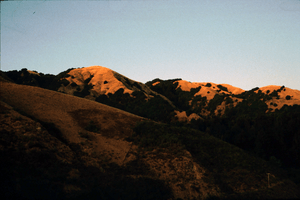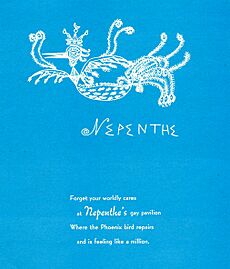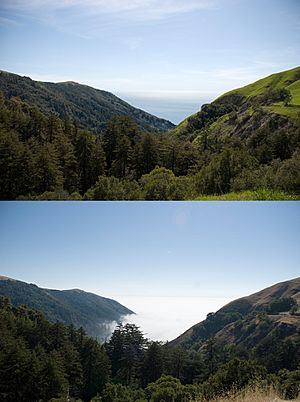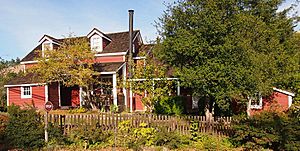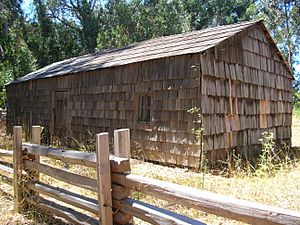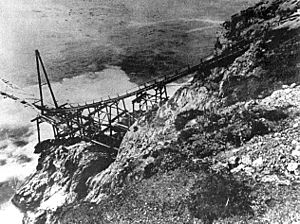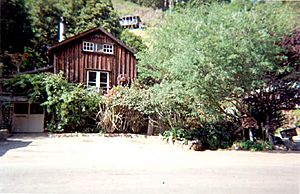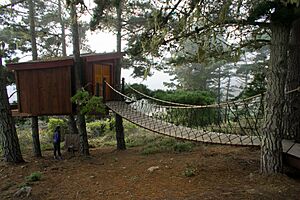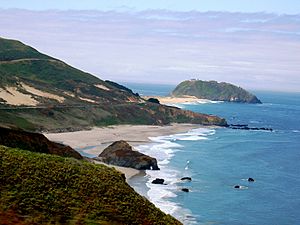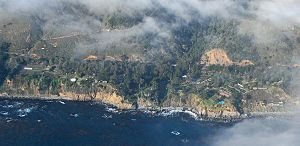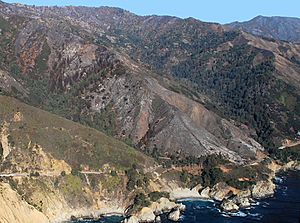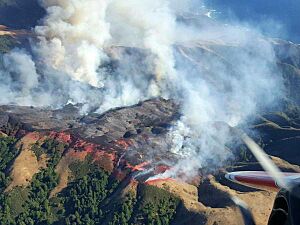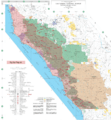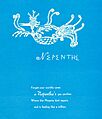Big Sur facts for kids
Quick facts for kids
Big Sur, California
|
|
|---|---|
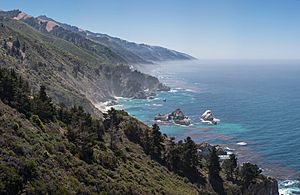
Coastline
|
|
| Country | United States |
| State | California |
| Counties | Monterey, San Luis Obispo |
Big Sur is a beautiful, wild part of California's Central Coast. It's where the Santa Lucia Mountains meet the Pacific Ocean in a dramatic way. People love Big Sur for its amazing views and natural beauty. It's often called one of the most scenic coastlines in the world!
Many visitors come to Big Sur each year to see the views, explore redwood forests, go hiking, and visit beaches. It's a very popular place, like Yosemite National Park, but it has fewer stores, roads, and parking spots.
Big Sur isn't a single town. It's a large area that stretches about 71 miles along California State Route 1. This famous highway winds along towering cliffs, offering incredible ocean views. Building this road was a huge project that took 18 years, finishing in 1937. Sometimes, parts of the highway close because of landslides, but they are usually reopened.
The Big Sur area is protected by special rules to keep it natural and beautiful. These rules make sure that new buildings don't spoil the amazing views from the highway. A lot of the land is owned by the government or other groups that protect it from development. This includes parts of the Los Padres National Forest and Ventana Wilderness.
Contents
- Exploring Big Sur: California's Stunning Coast
- Why is Big Sur So Special?
- Fun Things to Do in Big Sur
- Big Sur's Natural Wonders
- Big Sur's Climate and Weather
- Big Sur's History and People
- Modern Challenges and Life in Big Sur
- State and Federal Lands in Big Sur
- Wildfires in Big Sur
- Education and Safety
- Images for kids
- See also
Exploring Big Sur: California's Stunning Coast
Big Sur is not a city or town. It's a region in California without exact borders. People often think of "Big Sur Village" as the main spot, but that's just a small group of businesses.
Where is Big Sur Located?
The Big Sur region usually starts at Malpaso Creek in the north. This is about 4.5 miles south of the Carmel River. It stretches south to San Carpóforo Creek in San Luis Obispo County.
Most visitors only see the coastline. The Santa Lucia Mountains here go inland from 3 to 12 miles. Some people think Big Sur includes all the wild areas that drain into the Pacific Ocean.

What Does "Big Sur" Mean?
The name "Big Sur" comes from early Spanish explorers. They called the large, wild area south of Monterey el país grande del sur, which means 'the big country of the south'. They often shortened it to el sur grande, or 'the big south'.
The two main rivers in this area were named El Rio Grande del Sur (Big River of the South) and El Rio Chiquito del Sur (Little River of the South).
The first post office in the area was called "Posts." But in 1915, people asked to change the name to Big Sur. This helped make "Big Sur" the official name for the whole area.
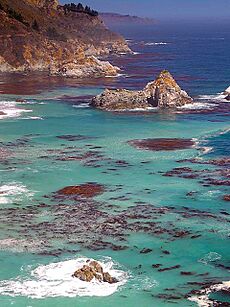
Why is Big Sur So Special?
The section of Highway 1 through Big Sur is known as one of the most beautiful drives in the United States. It's even called an "All-American Road."
Amazing Views and Protection
Big Sur was ranked as one of the top destinations in the U.S. because of its stunning natural beauty. There are no billboards or big advertisements along the highway. This helps keep the area looking wild and natural.
In 1965, this part of Highway 1 was named the first California Scenic Highway. Later, in 1996, the U.S. government called it an "All-American Road." McWay Falls is even called the most beautiful place in California!
Driving the Coast
Driving along Highway 1 in Big Sur is often called "one of the best drives on Earth." It's also a top spot for motorcycle rides.
Many people visit Big Sur, sometimes as many as Yosemite National Park. But Big Sur is different because it has limited services. There's only one narrow, two-lane highway that hugs the cliffs. During busy times, traffic can get very slow. In winter, the road sometimes closes due to bad weather or landslides.
Protecting the Land
Even though it's popular, Big Sur is strongly protected. The entire coast is part of a "coastal zone" that limits building. This helps keep the land natural and beautiful. The rules say that Big Sur is meant to be an experience you pass through, not a place with lots of new buildings.
Fun Things to Do in Big Sur
Besides driving and enjoying the views, Big Sur offers many outdoor activities.
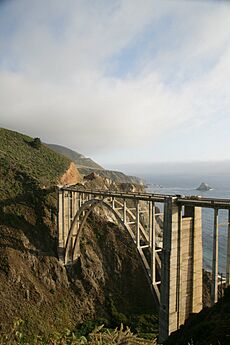
Famous Landmarks
- McWay Falls: This waterfall at Julia Pfeiffer Burns State Park is one of only two in California that drops right into the ocean! Parking can be tough on busy days.
- Point Sur Lightstation: This is an old lighthouse complex from the 1800s that you can visit. It's the only one of its kind open to the public in California.
- Ventana Wildlife Center: Near Andrew Molera State Park, this center teaches visitors about the California Condor recovery program and other wildlife.
- Henry Miller Memorial Library: This is a bookstore and arts center that honors the writer Henry Miller. He lived in Big Sur for many years and wrote about it. It's a cool place for people who love books and art.
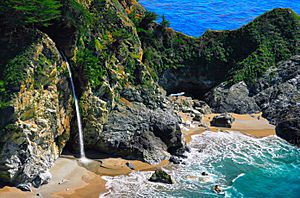
Amazing Beaches
Big Sur has beautiful beaches, but they are usually too cold or have strong currents for swimming. They are great for walking and taking photos!
- Garrapata State Park Beach: Many people say this is the best beach in Big Sur. You might see sea otters, sea lions, or even whales here.
- Pfeiffer Beach: This popular beach has a cool arch-shaped rock offshore. It can get crowded, so parking is limited.
- Sand Dollar Beach: This is the longest beach in Big Sur. It's great for hikers and photographers.
- Jade Cove: This spot, south of Sand Dollar Beach, is sometimes popular with visitors.
Some beaches are on private land and cannot be reached by the public.
Fun Hikes
Big Sur has many trails for hiking, especially in the Ventana Wilderness.
- Pine Ridge Trail: This is a very popular trail that leads to many campsites.
- Mt. Manuel Trail: This trail starts in Pfeiffer Big Sur State Park and goes up the slopes of Mt. Manuel.
- North Coast Ridge Road: This road is now a hiking trail with amazing views for almost the whole way.
Many trails in the state parks were closed after the Soberanes Fire and winter storms. Always check if trails are open before you go.
Places for Quiet Reflection
- Esalen Institute: This place is known for its natural hot springs and for teaching about different philosophies.
- New Camaldoli Hermitage: This is a Catholic monastery where visitors can stay in simple rooms for quiet meditation.
- Tassajara Zen Mountain Center: This Zen center is deep in the Los Padres National Forest and is open to guests in the summer.
Big Sur's Natural Wonders
Big Sur has many different types of plants and animals because of its varied climate. You can find rare orchids and even Tule elk here.
Redwood Trees
The tall coast redwood trees grow in Big Sur. They love the moisture from the fog and rain. These trees are protected from fire and insects by their thick bark.
Many redwood trees were cut down in the past for lumber. But some large groves in hard-to-reach places were never logged. The southernmost naturally growing redwood trees are found in Big Sur.
Amazing Wildlife
The Big Sur area is home to many animals like mountain lions, deer, foxes, and coyotes. You might also see wild boars, which were brought here from Russia a long time ago.
- California grizzly bears used to live here, but they are no longer found in California.
- Steelhead fish live in the Little Sur River and Big Sur River. These fish are a threatened species.
- California condors: These are very rare birds. A special program releases condors raised in captivity into the wild in Big Sur. They are doing well, and some have even nested in redwood trees!
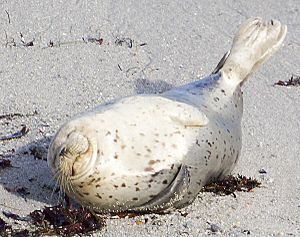
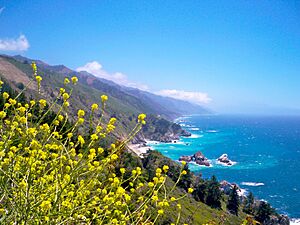
Protecting Ocean Life
The ocean area off the Big Sur coast is also protected. It's part of the Monterey Bay National Marine Sanctuary. This sanctuary has other special areas like:
- Point Lobos State Marine Reserve
- Point Sur State Marine Reserve and Marine Conservation Area
- Big Creek State Marine Reserve and Marine Conservation Area
These underwater parks help protect ocean wildlife and ecosystems.
Big Sur's Climate and Weather
Big Sur usually has a mild Mediterranean climate. Summers and falls are sunny and dry. Winters are cool and wet.
- Coastal temperatures: 50s to 70s Fahrenheit from June to October, and 40s to 60s from November to May.
- Inland temperatures: Can change a lot more.
- Fog: Common in summer, especially below 2,000 feet. It often rolls in at night and clears during the day.
- Rainfall: Big Sur gets a lot of rain in winter, especially from December to March. Snow is rare on the coast but common on higher mountains.
| Climate data for Big Sur, California (1991–2020 normals, extremes 1993–present) | |||||||||||||
|---|---|---|---|---|---|---|---|---|---|---|---|---|---|
| Month | Jan | Feb | Mar | Apr | May | Jun | Jul | Aug | Sep | Oct | Nov | Dec | Year |
| Record high °F (°C) | 81 (27) |
85 (29) |
88 (31) |
98 (37) |
96 (36) |
102 (39) |
103 (39) |
101 (38) |
111 (44) |
102 (39) |
90 (32) |
78 (26) |
111 (44) |
| Mean maximum °F (°C) | 73.1 (22.8) |
74.1 (23.4) |
78.2 (25.7) |
83.9 (28.8) |
85.9 (29.9) |
90.0 (32.2) |
90.5 (32.5) |
92.1 (33.4) |
93.3 (34.1) |
90.1 (32.3) |
79.6 (26.4) |
69.8 (21.0) |
98.4 (36.9) |
| Mean daily maximum °F (°C) | 60.5 (15.8) |
61.1 (16.2) |
64.2 (17.9) |
67.3 (19.6) |
70.5 (21.4) |
74.2 (23.4) |
75.4 (24.1) |
77.4 (25.2) |
76.8 (24.9) |
73.5 (23.1) |
65.3 (18.5) |
59.3 (15.2) |
68.8 (20.4) |
| Daily mean °F (°C) | 51.4 (10.8) |
51.9 (11.1) |
53.7 (12.1) |
55.4 (13.0) |
58.0 (14.4) |
61.1 (16.2) |
63.0 (17.2) |
63.8 (17.7) |
63.5 (17.5) |
61.0 (16.1) |
55.3 (12.9) |
50.9 (10.5) |
57.4 (14.1) |
| Mean daily minimum °F (°C) | 42.4 (5.8) |
42.8 (6.0) |
43.3 (6.3) |
43.5 (6.4) |
45.5 (7.5) |
48.0 (8.9) |
50.5 (10.3) |
50.1 (10.1) |
50.1 (10.1) |
48.5 (9.2) |
45.4 (7.4) |
42.5 (5.8) |
46.1 (7.8) |
| Mean minimum °F (°C) | 33.8 (1.0) |
34.0 (1.1) |
34.8 (1.6) |
35.3 (1.8) |
39.0 (3.9) |
41.1 (5.1) |
43.7 (6.5) |
43.9 (6.6) |
42.5 (5.8) |
39.8 (4.3) |
36.7 (2.6) |
33.8 (1.0) |
30.1 (−1.1) |
| Record low °F (°C) | 27 (−3) |
26 (−3) |
27 (−3) |
28 (−2) |
35 (2) |
37 (3) |
41 (5) |
40 (4) |
39 (4) |
31 (−1) |
28 (−2) |
27 (−3) |
26 (−3) |
| Average precipitation inches (mm) | 9.48 (241) |
8.59 (218) |
6.72 (171) |
2.94 (75) |
1.15 (29) |
0.20 (5.1) |
0.06 (1.5) |
0.05 (1.3) |
0.13 (3.3) |
1.88 (48) |
4.16 (106) |
9.18 (233) |
44.54 (1,131) |
| Average precipitation days (≥ 0.01 in) | 10.7 | 11.2 | 10.2 | 6.3 | 3.7 | 0.8 | 0.3 | 0.4 | 0.7 | 3.0 | 6.9 | 10.6 | 64.8 |
| Source: NOAA | |||||||||||||
Big Sur's History and People
People have lived in Big Sur for a very long time.
Early Inhabitants
Archaeological finds show that the Esselen people lived in Big Sur as early as 3500 BC. They were hunter-gatherers, meaning they moved around to find food. They used special holes in rocks to grind acorns into flour.
The Esselen used controlled fires to help trees grow and create more food. The mountains made the area hard to reach, so not many people lived there.
Spanish Explorers
The first Europeans to see Big Sur were Spanish sailors in 1542. They sailed past the coast, which they described as "mountains which seem to reach the heavens."
In 1769, a Spanish expedition led by Gaspar de Portolá was the first to enter the Big Sur region by land. They found the coast too difficult to travel along. They had to go inland through the mountains, which was a very hard journey.
Later, the Spanish built missions in California. They brought Native Americans to live and work at these missions. Many Native Americans got sick from diseases they had never been exposed to.
Early Settlers and Homesteaders
After California became part of Mexico, and then the United States, a few brave settlers came to Big Sur.
- John Davis was the first known European settler in 1853.
- The Cooper Cabin, built in 1861, is the oldest building still standing in Big Sur.
- William B. Post built a cabin in 1867. This "Post House" is now a historic landmark.
- Michael Pfeiffer and his family settled in Big Sur in 1869. They loved the area and stayed.
The U.S. government offered free land to settlers. This brought more people to Big Sur. Many places in Big Sur are named after these early families, like Bottcher, Cooper, and Pfeiffer.
Industries of the Past
In the past, Big Sur had industries like logging, gold mining, and limestone processing.
- Lumbermen cut down many coast redwood trees.
- They also harvested tanoak bark, which was used to make leather.
- Gold was found in the 1880s, leading to a small gold rush town called Manchester. But it didn't last long.
These industries needed ways to transport goods. They used "dog-hole ports" where ships could anchor offshore. Goods were loaded using cables and chutes.
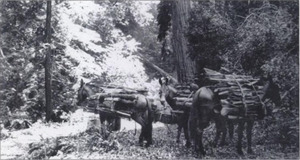
Modern Challenges and Life in Big Sur
Big Sur has become very popular, which brings both good things and challenges.
Crowds and Traffic
The number of visitors to Big Sur has grown a lot. This means that during summer weekends and holidays, Big Sur can get very crowded. Traffic on Highway 1 can be slow, and parking is limited.
Residents are concerned about the impact of so many visitors. There are few public buses and limited parking. Some visitors don't follow the rules, like camping illegally.
Limited Services
Because Big Sur is so protected, there aren't many places to stay or eat. Hotels and campgrounds are limited and can be expensive. There are only a few small groups of businesses, like in Posts, Lucia, and Gorda. You won't find big chain hotels or fast-food restaurants here.
There are also very few gas stations, and gas can be expensive. Camping is only allowed in special campsites, not along the roads.
Culture and Famous Residents
Big Sur has attracted many artists and writers over the years.
- Robinson Jeffers wrote poems about the wild beauty of Big Sur in the early 1900s.
- Henry Miller lived in Big Sur for almost 20 years (1944-1962). He wrote about his life there in his book Big Sur and the Oranges of Hieronymus Bosch.
- The TV series Big Little Lies was filmed in the area, which has also made Big Sur more popular.
Many well-known people have called Big Sur home.
- Ansel Adams (photographer)
- Lawrence Ferlinghetti (author)
- Al Jardine (musician)
- Henry Miller (author)
- Kim Novak (actress)
- David Packard (business executive)
- Linus Pauling (Nobel Prize winner)
- Trent Reznor (musician)
- Edward Weston (photographer)
State and Federal Lands in Big Sur
Many parts of Big Sur are protected as state parks or federal lands. This helps keep the natural beauty safe for everyone.
State Parks
The state parks in Big Sur were created because early residents wanted to protect the land.
- Garrapata State Park
- Point Sur State Historic Park
- Andrew Molera State Park
- Pfeiffer Big Sur State Park
- Julia Pfeiffer Burns State Park
- Limekiln State Park
Federal Lands
- Pfeiffer Beach
- Los Padres National Forest
- Ventana Wilderness
- Silver Peak Wilderness
Wildfires in Big Sur
Fires are a natural part of the Big Sur environment, especially in the chaparral areas. Native Americans used to set controlled fires to help the land.
Recent Fires
In recent years, Big Sur has had several large wildfires:
- The Basin Complex Fire in 2008 caused Highway 1 to close and forced people to leave their homes.
- The Pfeiffer Fire in 2013 destroyed many homes.
- The Soberanes Fire in 2016 was started by an illegal campfire. It burned a huge area and caused more evacuations and road closures.
- The Dolan Fire in 2020 was started on purpose and sadly killed many California Condors.
Fires can be very dangerous, but they also help some plants, like redwoods, by clearing out other plants that compete with them.

Education and Safety
Big Sur has a few schools for its small population.
- Captain Cooper School: Serves students from kindergarten to 5th grade in the northern part of Big Sur.
- Pacific Valley School: Serves students from kindergarten to 12th grade in the southern part.
Fire Protection
Big Sur has two volunteer fire departments that help in emergencies. Because the area is so remote, it can take a while for help to arrive. These brave volunteers are trained in many types of rescues and firefighting.
Images for kids
-
View of Gorda, one of the small clusters of services in Big Sur
-
Big Sur: rocky coast, fog and giant kelp
-
Bixby Creek Bridge, shown here looking southwest, is a popular attraction in Big Sur.
-
McWay Falls and McWay Cove
-
A harbor seal on a Big Sur beach
-
Big Sur coast looking south near Julia Pfeiffer Burns State Park
-
A major forest product of the Big Sur coast was the bark of Tanbark Oak.
-
Deetjen's Big Sur Inn is listed on the National Register of Historic Places.
-
FEMA team assesses wildfire damage after the Basin Fire, 2008
See also
 In Spanish: Big Sur para niños
In Spanish: Big Sur para niños
- Big Sur Land Trust
- Pacific Coast Highway
- Bixby Bridge
- McWay Falls
- Monterey County
- Big Sur River
- Big Little Lies (TV series)
- Yosemite National Park
- Adirondack Mountains






